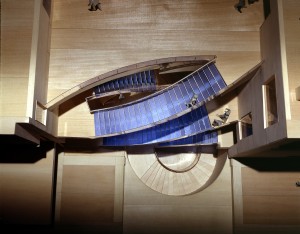The preservation of artistic and architectural legacies through the creation of physical and digital archives is of great significance to the future of art history. The Department of Art History is pleased to have reached an agreement to sustain the field of architectural history with the creation of an archive of the work of Voorsanger Architects PC of New York City. (www.voorsangerarchitects.com). Under the leadership of visual resources curator Christine Dent and faculty member and architectural historian Dr. Victoria Young, graduate students will be involved in the creation process of the archive from the ground up. Our first graduate student assistant for the project, Hanna August-Stoehr, documents her role in the earliest phases of the Voorsanger Architects Digital Archive.
I began my work on the Voorsanger Architects Digital Archive as a newly minted graduate student in the University of St. Thomas Art History program. During my interview with Christine Dent, Visual Resources Curator, I received an introduction to the project and my duties. I would organize and digitize the collection, finally entering the materials into the Art History database, Qi, and ContentDM. The ultimate goal was to allow interested art and architectural historians easy access to architectural planning materials, diagrams, drawings, and renderings. As I looked through books, familiarized myself with projects, and took about a whole notebook’s worth of notes on my first day on the job, I learned that Bartholomew Voorsanger’s architectural designs capitalized not just on the client’s design requirements, but on their close connection to natural materials and forms. The more I learned, the more enthusiastic I became about the part I was going to play in these preservation efforts.
Contrary to my initial impressions, I would not immediately become a slave to the scanner. Before any digitization of the massive collection could happen, an accurate inventory of the archival materials was required. Architectural Historian, Dr. Victoria Young, had received an alarming number of boxes from Voorsanger’s New York office. I began my work by organizing the materials from an ongoing Voorsanger Architects project, the National WWII Museum in New Orleans. As my parents had just returned from a trip to New Orleans that had included a visit to that same museum (they thought it fantastic), I was very interested in learning about the background of the architectural design choices.
I began by organizing everything by date, assessing the contents of each three-ring binder and folder, and then I described it all in a very detailed notebook, which I would later spend a good several hours transferring to Microsoft Word. My dedication to the project became fully certified after I spent an afternoon reading a full report on the varying qualities of a specific type of cement chosen for the foundation of the National WWII Museum. After weeks of organizing collections, I finally started digitizing.
It started with some really dirty slides of the Asia Society, located in New York City. I cleaned the slides up, popped them into the scanner, and dug back into my memory to remember how to scan! After this long process, Christy (who is very patient!) talked me through the delicate process of entering these scans into the digital archive. I learned Library of Congress name and title headings, what tags to capitalize, what to leave in lowercase, and which lists needed to be separated by semi-colons, and which by commas.
- Asia Society and Museum, New York: Model: View of staircases from above
- Asia Society and Museum, New York: Model
Finally, after learning all this, I was asked to assist in a graduate student digital archiving workshop. Fortunately, I was in charge of teaching students how to scan and do minor image touch-ups, and not showing them how to enter data into the archive. I had a great time meeting my St. Thomas colleagues and showing them a few Photoshop tricks.
Several weeks later, Bartholomew Voorsanger came to visit. In one exhaustive afternoon, we walked him through our databases, showed him our sorting systems, and prioritized which projects would be uploaded in the next few weeks. After a long conference call with his New York office, we went out to lunch. Though only a few steps in the long process of archival digitization had been completed, each played a vital role in the development of the next. As I look back on my small part, I am grateful for the opportunities that working on the Voorsanger Architects Digital Archive provided me. This April I am headed to New York City…and my itinerary is already full of visits to Voorsanger Architects designed buildings.




